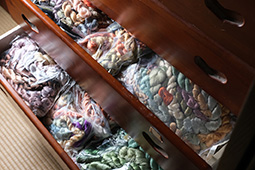INDEX
- English
- 日本語

Cherry blossoms made of silk - English
- 日本語

A hirakusu wreath of Japanese silver grass and egret made from silk

Nishijin silk thread 
A hirakusu wreath made with chrysanthemums, irises and other flowers associated with the Gosekku ceremony
September 2020
Silk Flowers Conveying the Elegance of the Court

The custom of making and displaying silk flowers, which began in the imperial court in around the eighth century, continues to this day, with one expert practitioner very much to the fore.

The word “yusoku” refers to the rules of ceremonies and events in the imperial court and related rules implemented by the nobles who served the emperor and samurai. “Yusoku silk flowers” as they are known today were used as decorations on such occasions. The flowers, which were made in a specific, formal style, appear in waka poetry from as early as the middle of the eighth century. Later, in the fourteenth century, the Karin school of artificial flower making was founded, and the art of making silk flowers further developed as a part of court culture.
Among the court events in Japan, the Gosekku (January 7, March 3, May 5, July 7, and September 9) are important ceremonies held to dispel evil spirits at the changing of the seasons. Introduced from China, the ceremonial events took hold among the common people and continue to be practiced to this day.
Use of the flowers has expanded from decorations at court events to wedding ceremonies for samurai and, in more recent years, to events or festivals involving the general public.
The most popular of the festivals today rooted in the old court events is Momo no Sekku (“Peach Festival,” more commonly known as Girls’ Day), held annually on March 3. On this date households display hina-ningyo ornamental dolls wearing imperial clothing to wish for the healthy growth of girls and happiness in their homes. Yusoku silk flowers of the cherry and tachibana orange trees are also displayed on this occasion.

A variety of other specific styles have been developed, such as kusudama incense balls made of silk flowers and hirakusu silk flower wreaths, and these decorative forms survive to this day. The beautiful designs of yusoku silk flower arrangements remain courtly and elegant.
Oki Suju is one of the few masters of the yusoku silk flower art form still working today. Oki studied the techniques on his own after becoming fascinated with the flowers’ elegance.
“Rather than being an imitation of a flower, there is a dedication to realism,” he says. “The most fascinating part is recognizing the intrinsic beauty of the flowers and then elevating it to the stylistic beauty of the yusoku silk flowers.” The colors, richer and brighter than real flowers, are part of the yusoku style that allowed the flowers to appear brilliant even in dimly lit rooms at a time long ago when there were no electric lights.
The flowers, petals, leaves, and other features of yusoku silk flowers are created by taking silk cloth lined with dyed washi paper and cutting it with metal dies or scissors. The cut-outs are then shaped into three-dimensional forms with elegant curves by pressing them against a heated kote, a metal tool also used to flatten out silk. The parts, carefully made one by one using a variety of cutting dies and kote, are then brought together into the desired shape—for example, a flowering tree or a wreath—using silk thread and a frame. A cherry tree design might have 3,000 individual artificial flowers. Creating such displays is a time-consuming task.

Oki says, “You can make similar flower shapes using paper alone, but the texture is completely different from silk. The soft luster of silk breathes life into the flowers and reproduces the character of the court culture.”
The silk thread used in yusoku silk flower design is the same thread used to weave obi sashes in Nishijin, a famous textile producing district of Kyoto. It is essential to have a variety of types of thread and a number of colors. For example, to express pine needles, a slightly firm and frizzy silk thread is needed, whereas for the heads of maiden silver grass, a flexible, shiny silk thread is required.
Oki laments, “Demand for the making of yusoku silk flowers has dwindled, and I handle all the work that in the past was divided up. The number of specialists who create dies and kote has also declined, and it will certainly be difficult to pass on the techniques to the next generation.”
Oki is working to reproduce the yusoku silk flowers described in early literature and documents to throw more light on the history of the flowers and hand it down. He is also experimenting with ways to express seasonal scenes encountered when out on a walk. Oki says that he sees yusoku silk “flowers” in practically everything, and he expresses what he sees every day—not just flowers, but also the moon, animals, and bugs—within the framework of the traditional style. In this way, Oki hopes, the tradition of yusoku silk flower making will take root again and blossom.

